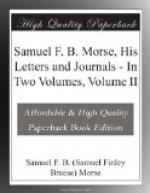“The papers burnt are all the drawings, all the books filed, Dana’s lectures, Chester’s pamphlet, your sketchbook (if the original was there), your tag of type, etc., etc. But we shall replace them as far as possible and go on with the case. Was your original sketch-book there? If so, has any copy been taken?”
The original sketch-book was in this collection of papers so mysteriously destroyed, but most fortunately a certified copy had been made, and this is now in the National Museum in Washington. Also, most fortunately, this effort on the part of some enemy to undermine the foundations of the case proved abortive, if, indeed, it was not a boomerang, for, as we have seen, the decision of the Supreme Court was in Morse’s favor. In the year 1852, Commodore Perry sailed on his memorable trip to Japan, which, as is well known, opened that wonderful country to the outside world and started it on its upward path towards its present powerful position among the nations. The following letter from Commodore Perry, dated July 22, 1852, will, therefore, be found of unusual interest:—
I shall take with me, on my cruise to the East Indias, specimens of the most remarkable inventions of the age, among which stands preeminent your telegraph, and I write a line by Lieutenant Budd, United States Navy, not only to introduce him to your acquaintance, but to ask as a particular favour that you would give him some information and instruction as to the most practicable means of exhibiting the Telegraph, as well as a daguerreotype apparatus, which I am also authorized to purchase, also other articles connected with drawing.
I have directed Lieutenant Budd to visit Poughkeepsie in order to confer with you. He will have lists, furnished by Mr. Norton and a daguerreotype artist, which I shall not act upon until I learn the result of his consultation with you.
I hope you will pardon this intrusion upon your time. I feel almost assured, however, that you will take a lively interest in having your wonderful invention exhibited to a people so little known to the world, and there is no one better qualified than yourself to instruct Lieutenant Budd in the duties I have entrusted to his charge, and who will fully explain to you the object I have in view.
I leave this evening for Washington and should be much obliged if you would address me a line to that place.
Most truly and respectfully yours
M.C. PERRY.
It was about this time that the testimony of Professor Joseph Henry was being increasingly used by Morse’s opponents to discredit him in the scientific world and to injure his cause in the courts. I shall, therefore, revert for a moment to the matter for the purpose of emphasizing Morse’s reluctance to do or say anything against his erstwhile friend.
In a letter to H.J. Raymond, editor of the New York “Times,” he requests space in that journal for a fair exposition of his side of the controversy in reply to an article attacking him. To this Mr. Raymond courteously replies on November 22, 1852: “The columns of the ‘Times’ are entirely at your service for the purpose you mention, or, indeed, for almost any other. The writer of the article you allude to was Dr. Bettner, of Philadelphia.”




